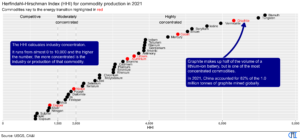The “Energy Transition” will reduce demand for fossil fuels and cut greenhouse gas emissions. However, the shift relies on a step-up in consumption of some commodities. Commodities, where supply is already tight and highly concentrated, so adding risks to and slowing the transition.
Today’s electric vehicle s are powered by lithium-ion batteries, needing lithium and graphite, and often cobalt and nickel. Permanent magnets in wind turbine can weigh 4 tonnes, and are made up of 34% rare earth elements1. Whether connecting up banks of turbines or providing charging points for EVs, copper is needed for cabling. These commodities share traits that supply of each will need to grow to achieve emissions’ targets and global supply is reliant on a limited number of countries.
s are powered by lithium-ion batteries, needing lithium and graphite, and often cobalt and nickel. Permanent magnets in wind turbine can weigh 4 tonnes, and are made up of 34% rare earth elements1. Whether connecting up banks of turbines or providing charging points for EVs, copper is needed for cabling. These commodities share traits that supply of each will need to grow to achieve emissions’ targets and global supply is reliant on a limited number of countries.
The International Energy Authority (IEA) forecasts that supply of copper, which has a large annual production already, needs to triple by 2040 relative to 2020-supply to meet the Sustainable Development Scenario – difficult, but achievable. However, for minor commodities the increase in supply is a large stretch and may be too much to achieve, with lithium supply needing to increase 42-fold and graphite 25-fold2.
Compounding the lack of supply is high industry concentration. With larger commodities, mining and processing is often distributed across many countries. With minor commodities, this is concentrated in a few places.
The Herfindahl–Hirschman index (HHI) shows the scale of the problem, by calculating the concentration of each commodity’s production base. Where a commodity is mostly mined in a limited number of countries or where one country is the dominant source this is reflected in a higher HHI.
Last year’s production data shows the worrying concentration of some critical, minor commodities. The high concentration of graphite, lithium and cobalt all point to one country, usually China, dominating the flow of the material.
The concerns that these critical commodities are needed for the energy transition, but have restricted suppliers is pushing many governments to develop plans to ensure access. New mines are being developed in fresh regions and novel recycling processes championed to diversify the supply base, but until these facilities come on-line, ramp-up and bring meaningful flows, concentration will remain a major risk to transitioning away from fossil fuels and meet net-zero goals.


